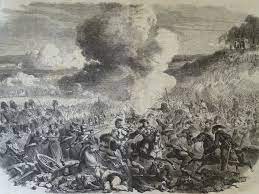The Crimean War
Created by Lauren Hawker on Thu, 10/06/2022 - 00:21
Part of Group:
The Crimean War began in 1853 when Czar Nicholas I of Russia began his attempt to expand his territory into the Middle East and part of the Mediterranean, this would diminish the Ottoman Empire. There was a “conflict over the holy places of Palestine” (Bayly 160), which was an “important trigger” (Bayly 160) for the war. When Russia began its expansion of the holy lands for Christains, Britain and France were offended as well as worried about their trading routes, which led to them entering the war. While the war takes place mostly on the Crimean Peninsula, the war was about Palestine. Particularly the expansion of Russia. Britain and France feared a vast Russian empire and what it would do to Europe.

This war was the first since the Napoleonic Wars in which the French were the foe for the British, but how the two were in an alliance. As the war progressed, British citizens saw events from battlefields and camps “through the emergent media culture of frontline war correspondents, artists, and photographers” (Markovits). This provided the public with a whole new view and perspective on war. A great example of this is the notable poem, “The Charge of the Light Brigade” by Lord Tennyson. The poem was written to honor the British heroes of a brigade at the Battle of Balaklava which took place in 1854. The soldiers were considered heroes because they followed orders without hesitation, it was discovered those orders were a miscommunication. Of the roughly 600 soldiers in the brigade, less than 200 made it out alive. With writers such as William Howard Russell, the first professional war correspondent, writing for The Times the public saw first hand accounts of the charge. There was a confusion for people, they didn’t know if they should feel patriotic or disgusted by the Charge of the Light Brigade. The confusion inspired many authors, artists. After viewing different pieces of media that depicted the war, the public came to appreciate individuals of the war, however the majority were not soldiers with muskets but people like William Howard Russell and Florence Nightingale, the founder of modern nursing.
The Crimean War is responsible for bringing up the conversation of female roles within war. While The Woman in White by Willkie Collins is not about women in war, there are many discussions of the female role in life. Particularly with Miss Laura Fairlie and Miss Marian Holcome. Miss Fairlie is the stereotypical innocent and naive damsel in distress. While her sister, Miss Halcome oversees Limmeridge House even though her uncle is the patriarch of the family, she takes on many masucline roles to ensure the safety and wellbeing of Miss Fairlie. Collins does something very interesting in writing Marian the way he does, he doesn't allow her to conform to gender roles. This is very comparable to women such as Florence Nightingale. While most female nurses in the war focused on helping the injured men, “Nightingale herself had more interest in organizing the hospital than in ministering to the men” (Kriegel). Nightingale like Miss Halcome focused on the organization and facilitation, rather than interacting with individuals. These women share similar skill sets that would have been deemed masculine and unfit for a woman during the Victorian era.
Works Cited
Bayly, C. A. The Birth of the Modern World: 1780–1914. Blackwell, 2003.
Birns, Nicholas. “Sable Seas: The Crimean War’s Global Reach and 1850s Geopolitical Literariness.” Victorian Studies, vol. 63, no. 2, Jan. 2021, p. 169. EBSCOhost, discovery.ebsco.com/linkprocessor/plink?id=0255bb00-531c-383a-b984-1a42a05e468c.
Kriegel, Lara. “On the Death—and Life—of Florence Nightingale, August 1910.” BRANCH: Britain, Representation and Nineteenth-Century History. Ed. Dino Franco Felluga. Extension of Romanticism and Victorianism on the Net. Web.
Markovits, Stefanie. “On the Crimean War and the Charge of the Light Brigade.” BRANCH: Britain, Representation and Nineteenth-Century History. Ed. Dino Franco Felluga. Extension of Romanticism and Victorianism on the Net. Web.
